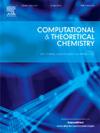Implications of DFT calculations on microkinetic predictions: The catalytic decomposition of CH4 on M13 (M = Fe, Ni, Ru, Pd and Pt) cluster
IF 3
3区 化学
Q3 CHEMISTRY, PHYSICAL
引用次数: 0
Abstract
A Kinetic Monte Carlo approach, combined with Density functional theory (DFT) calculations were employed to investigate the adsorption and dehydrogenation mechanisms of CH4 and its intermediate species CH3, CH2, CH and C, on metal clusters of Fe, Ni, Ru, Pd, and Pt. Adsorption energies calculated with both PBE and dispersion-corrected PBE-D3 functionals indicates significant variations in binding strength as dehydrogenation progressed. It is notable that methane was weakly physisorbed on all metals, with adsorption energies ranging from −0.13 eV on Ru13 to −0.41 eV on Pt13. Activation barriers for CH4 dehydrogenation were determined and compared with previous studies, revealing how the adsorption energies, activation energies, and reaction energies can differ based on metal type, geometry, and the chosen DFT method, and reaction pathway proposed. To complement the electronic structure and activation barrier results, a Kinetic Monte Carlo (KMC) approach was employed using the activation energies obtained from DFT to simulate the temperature-dependent evolution of surface intermediates and H2 desorption. This multiscale strategy allowed to capture the dynamic behavior of methane dehydrogenation on M13 clusters, revealing how variations in metal identity and adsorption energetics lead to distinct surface coverages and reaction behavior with temperature.

DFT计算对微动力学预测的影响:M13 (M = Fe, Ni, Ru, Pd和Pt)簇上CH4的催化分解
采用动力学蒙特卡罗方法,结合密度泛函理论(DFT)计算,研究了CH4及其中间体CH3、CH2、CH和C在Fe、Ni、Ru、Pd和Pt金属簇上的吸附和脱氢机理。通过PBE和分散化校正的PBE- d3官能团计算的吸附能表明,随着脱氢的进行,结合强度发生了显著变化。值得注意的是,甲烷在所有金属上都被弱物理吸附,吸附能在Ru13 - 0.13 eV到Pt13 - 0.41 eV之间。测定了CH4脱氢的激活势垒,并与前人的研究进行了比较,揭示了吸附能、活化能和反应能如何因金属类型、几何形状、所选择的DFT方法和所提出的反应途径而不同。为了补充电子结构和激活势垒的结果,采用动力学蒙特卡罗(KMC)方法,利用从DFT获得的活化能来模拟表面中间体和H2脱附的温度依赖演化。这种多尺度策略可以捕捉M13簇上甲烷脱氢的动态行为,揭示金属特性和吸附能量的变化如何导致不同的表面覆盖率和反应行为随温度的变化。
本文章由计算机程序翻译,如有差异,请以英文原文为准。
求助全文
约1分钟内获得全文
求助全文
来源期刊

Computational and Theoretical Chemistry
CHEMISTRY, PHYSICAL-
CiteScore
4.20
自引率
10.70%
发文量
331
审稿时长
31 days
期刊介绍:
Computational and Theoretical Chemistry publishes high quality, original reports of significance in computational and theoretical chemistry including those that deal with problems of structure, properties, energetics, weak interactions, reaction mechanisms, catalysis, and reaction rates involving atoms, molecules, clusters, surfaces, and bulk matter.
 求助内容:
求助内容: 应助结果提醒方式:
应助结果提醒方式:


